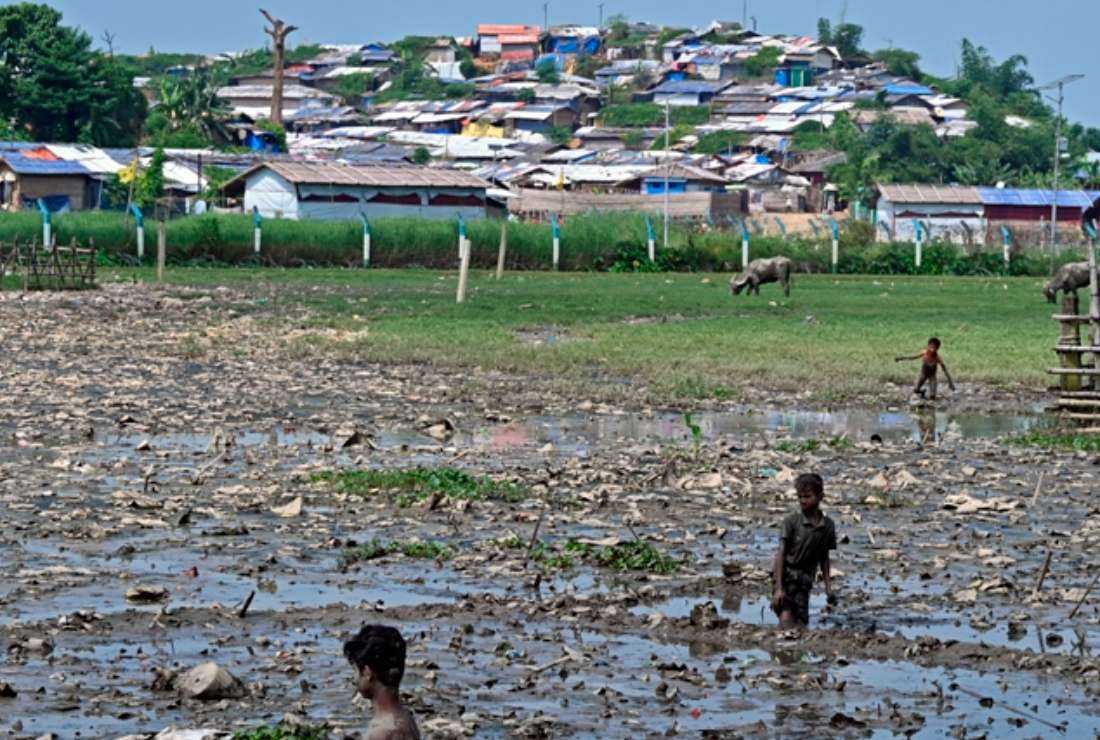
Infections and deaths may set new records this year at world's largest refugee camp in Cox's Bazar, warn health officials

Rohingya refugees stand amid garbage at the community's agricultural land at Kutupalong refugee camp in Ukhia, Bangladesh, on Sept. 29, 2022. Health officials warn that the cramped refugee camps in Cox's Bazar face the threat of a severe dengue outbreak this year. (Photo: AFP)
Nearly a million Rohingyas in cramped refugee camps in Bangladesh’s Cox's Bazar are staying put with the threat of a severe dengue outbreak.
Dengue infections have also reportedly surged in the camps in the border district of Bangladesh well ahead of the time considered to be the dengue season in the South Asian nation.
“Two Rohingya men have already died due to dengue fever,” said Sarwar Jahan, assistant health coordinator at the Office of the Refugee Relief and Repatriation Commissioner, who manages the refugee camp in Bangladesh.
It is the hottest time of the year with temperatures hovering over 40°C in many places in Bangladesh, which experts say is not conducive for Aedes mosquitoes, the vector of dengue, to breed in large numbers.
However, the camps – mainly housing Muslim refugees who have fled Myanmar’s military-led crackdown in 2017 – saw a 16-year-old boy die from viral fever in March.
The civil surgeon's office in Cox’s Bazar, responsible for the healthcare of the coastal district, confirmed an astronomical 1,066 dengue infections by May 25, compared with over 1,600.infections reported over the same period in the entire nation.
“It is likely both infections and deaths will set new records this year,” said epidemiologist Zakir Hossain.
Hossain said the disease was apparently getting stronger and may stick around almost the entire year.
“The Rohingya are particularly vulnerable to the disease because of their lack of awareness about it and the absence of prompt diagnosis of the disease at the camps,” the epidemiologist added.
The number of dengue cases in the first five months has usually remained less than 50 since 2000 when Bangladesh began to keep a tab on dengue infections, official records showed.
Healthcare workers and experts are worried about hygiene in the refugee camps and several extensions, housing a million refugees in 26 square kilometers, considered to be the largest in the world.
“There is a high possibility of a severe outbreak and we are preparing for it,” said Mahbubur Rahman, civil surgeon and chief health officer for Cox’s Bazar.
He warned that an Aedes mosquito can infect many within seconds, hence keeping densely populated refugee camps safe from mosquitoes is really difficult.
Shah Fahim Ahmad Faisal, medical officer of disease control at the office of the civil surgeon observed that the shanties in the camps serve as an ideal breeding ground for Aedes mosquitoes “as their plastic or polythene-covered roofs often collect rainwater in their folds.”
The dengue season in Bangladesh mostly starts in June, and peaks in September, according to the Directorate General of Health Services, Bangladesh.
The dengue outbreak occurs when light rains hit the country with high humidity – around 80 percent – and 16°C to 25°C temperatures.
About 80 percent of dengue-infected people remain asymptomatic while many others might experience pain in the knees, abdomen, or at the back of their eyes but never develop a fever, Hossain said.
But for Rohingya refugees accessing healthcare services in hospitals is difficult as they need special permission from the authorities to leave their camps, and the green signal does not come unless their physical condition is really bad.
The number of hospital beds is inadequate for a million refugees in Cox’s Bazar.
The 250-bed state-run Cox’s Bazar Sadar hospital has only 40 beds dedicated to dengue patients.
There are 67 organizations taking care of primary healthcare in Rohingya camps but meeting the needs of such a huge population, including about half a million children who are the most vulnerable group to mosquito bites, is an impossible challenge.
The stateless Rohingya people faced the wrath of Aedes mosquitoes last year too, reporting 17 deaths and 15,352 infections – the highest-ever dengue casualties reported in the refugee camps.
With 10 times more infections compared with 2021, last year the camps had become a dengue hotspot outside the capital Dhaka.
Dengue fever has already claimed 13 lives in Bangladeshis and infected over 1,600 others this year, including 634 infections in the first 25 days of May, the highest for the same period, since 2000.
Help us keep UCA News independent
The Church in Asia needs objective and independent journalism to speak the truth about the Church and the state.
With a network of professionally qualified journalists and editors across Asia, UCA News is just about meeting that need. But professionalism does not come cheap. We depend on you, our readers, to help maintain our independence and seek that truth.
A small donation of US$2 a month would make a big difference in our quest to achieve our goal.

Share your comments